
The Orchidoideae, or the orchidoid orchids, are a subfamily of the orchid family (Orchidaceae) that contains around 3630 species. Species typically have a single (monandrous), fertile anther which is erect and basitonic.

Coelia is a genus of orchids. It had previously been tentatively classified as the only genus of the subtribe Coeliinae of the tribe Epidendreae.

Platystele is a genus of orchids, comprising about 95 species. Most of these have small flowers, some of the smallest in the family. The genus is widespread across Mexico, Central America, the West Indies, and South America as far south as Bolivia, but infrequent in Brazil. Luer, C. A. 1990. Icones Pleurothallidinarum–VII. Systematics of Platystele (Orchidaceae). Monographs in systematic botany from the Missouri Botanical Garden 38: 1–135.

Aspidogyne is a genus of flowering plants from the orchid family, Orchidaceae. It includes about 40-50 species from Mexico, Central America, South America and Trinidad.
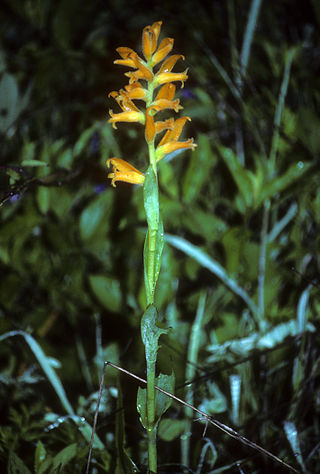
Dichromanthus is a genus of flowering plants from the orchid family, Orchidaceae. As currently delimited, it is monophyletic and includes four species:
- Dichromanthus aurantiacus(Lex.) Salazar & Soto Arenas - much of Mexico, south to Honduras
- Dichromanthus cinnabarinus(Lex.) Garay - from Texas to Guatemala
- Dichromanthus michuacanus(Lex.) Salazar & Soto Arenas - from Texas and Arizona south to Honduras
- Dichromanthus yucundaaSalazar & García-Mend. - Oaxaca

Dimerandra, abbreviated Dmd. in the horticultural trade, is a genus of flowering plants from the orchid family, Orchidaceae. The group is found across tropical America: southern Mexico, Central America, the West Indies and northern South America.

Triphora is a genus of flowering plants from the orchid family, Orchidaceae. It is native to South America, Central America, southern Mexico, the West Indies and eastern North America as far north as Ontario. Noddingcaps is a common name for plants in this genus.
- Triphora amazonicaSchltr. - Florida, Caribbean, south to Brazil
- Triphora carnosula(Rchb.f.) Schltr. - Brazil
- Triphora craigheadiiLuer - Florida
- Triphora debilis(Schltr.) Schltr. - southern Mexico, Costa Rica, Guatemala, Panama
- Triphora duckeiSchltr. - Brazil
- Triphora foldatsiiCarnevali - Venezuela
- Triphora gentianoides(Sw.) Nutt. ex Ames & Schltr. - Florida, Southern Mexico, Costa Rica, Veenzuela, Colombia, Ecuador, Bahamas, Greater Antilles
- Triphora hassleriana(Cogn. ex Chodat & Hassl.) Schltr. - from Mexico to Argentina
- Triphora heringeriPabst - Brazil
- Triphora miserrima(Cogn.) Acuña - Cuba, Hispaniola
- Triphora nitida(Schltr.) Schltr. - Costa Rica
- Triphora pusilla(Rchb.f. & Warm.) Schltr. - Brazil
- Triphora ravenii(L.O.Williams) Garay - Costa Rica, Panama
- Triphora santamariensisPortalet - Brazil
- Triphora surinamensis(Lindl. ex Benth.) Britton - West Indies south to Brazil
- Triphora trianthophoros(Sw.) Rydb. Ontario, Eastern United States, much of Mexico
- Triphora unifloraA.W.C.Ferreira, Baptista & Pansarin - Brazil
- Triphora wagneriSchltr. - from Mexico to Ecuador
- Triphora yucatanensisAmes - Florida and the Yucatán Peninsula

Homalopetalum is a genus of flowering plants from the orchid family, Orchidaceae. It contains 8 known species native to Central America, northern South America, Mexico and the West Indies.
- Homalopetalum alticola(Garay & Dunst.) Soto Arenas - Venezuela
- Homalopetalum hypoleptum(Lindl.) Soto Arenas - Brazil
- Homalopetalum kienastii(Rchb.f.) Withner - Mexico
- Homalopetalum leochilus(Rchb.f.) Soto Arenas - Cuba, Dominican Republic
- Homalopetalum pachyphyllum(L.O.Williams) Dressler - Mexico
- Homalopetalum pumilio(Rchb.f.) Schltr. - Mexico, Central America, Ecuador
- Homalopetalum pumilum(Ames) Dressler - Mexico
- Homalopetalum vomeriforme(Sw.) Fawc. & Rendle - Cuba, Jamaica

Ionopsis is a genus of flowering plants from the orchid family, Orchidaceae. It contains 6 currently accepted species, native to Latin America, the West Indies, and Florida.
- Ionopsis burchelliiRchb.f. - Brazil
- Ionopsis minutiflora(Dodson & N.H.Williams) Pupulin - Ecuador
- Ionopsis papillosaPupulin - Ecuador
- Ionopsis satyrioides(Sw.) Rchb.f. in W.G.Walpers - widespread across southern Mexico, Central America, the West Indies, and South America
- Ionopsis utricularioides(Sw.) Lindl. - widespread across southern Mexico, Central America, the West Indies, South America, and Florida
- Ionopsis zebrinaKraenzl. - Colombia
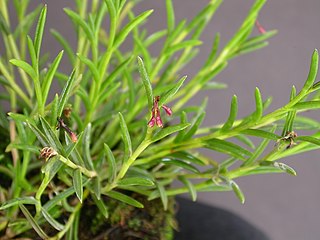
Jacquiniella is a genus of flowering plants from the orchid family, Orchidaceae. It is native to Mexico, Central America, the West Indies, and South America.
Thaia is a monotypic genus of flowering plants from the orchid family, Orchidaceae. The sole species is Thaia saprophytica, native to Laos and Thailand.
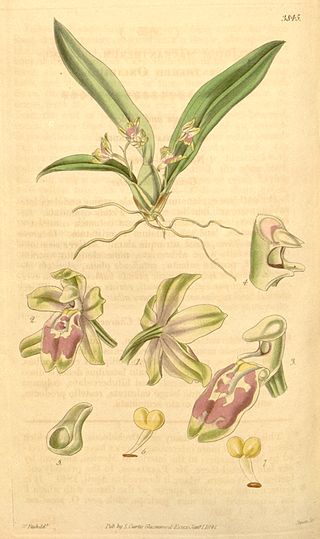
Leochilus is a genus of flowering plants from the orchid family, Orchidaceae, native to Mexico, Central America, northern South America, the West Indies and Florida.
- Leochilus carinatus(Knowles & Westc.) Lindl. - Oaxaca, Veracruz
- Leochilus crocodiliceps(Rchb.f.) Kraenzl. in H.G.A.Engler - Jalisco, Colima
- Leochilus hagsateriM.W.Chase - Oaxaca
- Leochilus inconspicuus(Kraenzl.) M.W.Chase & N.H.Williams - Costa Rica
- Leochilus johnstoniiAmes & Correll - from Oaxaca south to Nicaragua
- Leochilus labiatus(Sw.) Kuntze - from Oaxaca south to Brazil; also West Indies and Florida
- Leochilus leiboldiiRchb.f. - Oaxaca, Veracruz
- Leochilus leochilinus(Rchb.f.) M.W.Chase & N.H.Williams - Nicaragua, Costa Rica, Panama
- Leochilus oncidioidesKnowles & Westc. - Mexico, Guatemala, Honduras
- Leochilus puertoricensisM.W.Chase - Puerto Rico, St. Lucia
- Leochilus scriptus(Scheidw.) Rchb.f. - from southern Mexico south to Ecuador; also Cuba, Trinidad, Dominican Republic
- Leochilus tricuspidatus(Rchb.f.) Kraenzl. in H.G.A.Engler - Costa Rica, Panama
Mesadenus is a genus of flowering plants from the orchid family, Orchidaceae. It contains 6 currently recognized species, native to Mexico, Central America, the West Indies, Brazil and Florida.
- Mesadenus chiangii(M.C.Johnst.) Garay - Coahuila
- Mesadenus glaziovii(Cogn.) Schltr. - Rio de Janeiro
- Mesadenus lucayanus(Britton) Schltr. - widespread across Mexico, Florida, Guatemala, West Indies
- Mesadenus polyanthus(Rchb.f.) Schltr. - Mexico, Belize
- Mesadenus rhombiglossus(Pabst) Garay - Minas Gerais
- Mesadenus tenuissimus(L.O.Williams) Garay - Morelos

Prescottia is a genus of flowering plants from the orchid family, Orchidaceae. It is widespread across much of Latin America and the West Indies, with one species (P. oligantha) extending into Florida.
Pseudocentrum is a genus of flowering plants from the orchid family, Orchidaceae. It is native to Central America, the West Indies and northern South America.

Psilochilus is a genus of flowering plants from the orchid family, Orchidaceae. It is native to South America, Central America, Mexico and the West Indies.
- Psilochilus carinatusGaray - Colombia
- Psilochilus dusenianusKraenzl. ex Garay & Dunst. - Venezuela, Brazil
- Psilochilus macrophyllus(Lindl.) Ames - widespread from central Mexico and the West indies south to Peru
- Psilochilus maderoi(Schltr.) Schltr. - Colombia
- Psilochilus modestusBarb.Rodr. - Venezuela, Brazil
- Psilochilus mollisGaray - Ecuador
- Psilochilus physurifolius(Rchb.f.) Løjtnant - Venezuela, Guyana
- Psilochilus vallecaucanusKolan. & Szlach. - Colombia
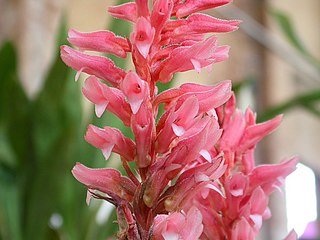
Sacoila is a genus of flowering plants from the orchid family, Orchidaceae, native to the Western Hemisphere. It occurs in Mexico, Central America, South America, the West Indies and Florida.

Schiedeella is a genus of flowering plants from the orchid family, Orchidaceae. It is native to the Western Hemisphere: Mexico, the West Indies and Central America, with one species (S. arizonica) in the southwestern United States.
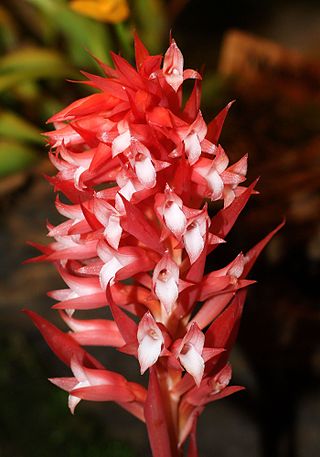
Stenorrhynchos is a genus of flowering plants from the orchid family, Orchidaceae. It is native to Mexico, Central America, the West Indies, and northern South America.

Neottieae is an orchid tribe in the subfamily Epidendroideae. It contains six genera and over 200 species distributed mainly in temperate and subtropical zones of the northern hemisphere. All its members are terrestrial plants, hinting at an early branching with Epidendroideae which is largely an epiphytic group. Neottieae is likely to be the result of a single temperate radiation of epidendroids, although it appears that some lineages in this tribe have crept back into the tropics.

















